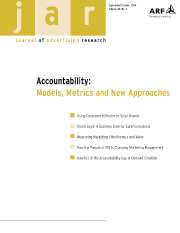Crossref Citations
This article has been cited by the following publications. This list is generated based on data provided by Crossref.
Kitt, Janette
and
Sträter, Peter
2008.
The Impact of Advertising in the U.S. Sweet Confection Market.
Journal of Advertising Research,
Vol. 48,
Issue. 1,
p.
22.
Tellis, Gerard J.
2008.
Important research questions in technology and innovation.
Industrial Marketing Management,
Vol. 37,
Issue. 6,
p.
629.
Molina-Murillo, Sergio A.
and
Smith, Timothy M.
2009.
Exploring the use and impact of LCA-based information in corporate communications.
The International Journal of Life Cycle Assessment,
Vol. 14,
Issue. 2,
p.
184.
Mulhern, Frank
2009.
Integrated marketing communications: From media channels to digital connectivity.
Journal of Marketing Communications,
Vol. 15,
Issue. 2-3,
p.
85.
Koslow, Scott
and
Tellis, Gerard J.
2011.
What Scanner-Panel Data Tell Us about Advertising.
Journal of Advertising Research,
Vol. 51,
Issue. sup1,
p.
87.
Henningsen, Sina
Heuke, Rebecca
and
Clement, Michel
2011.
Determinants of Advertising Effectiveness: The Development of an International Advertising Elasticity Database and a Meta-Analysis.
Business Research,
Vol. 4,
Issue. 2,
p.
193.
Suh, Munshik
Greene, Henry
Israilov, Baiastan
and
Rho, Taeseok
2015.
The Impact of Customer Education on Customer Loyalty Through Service Quality.
Services Marketing Quarterly,
Vol. 36,
Issue. 3,
p.
261.
Livas, Christos
2021.
The Powers and Perils of Societal Advertising.
Journal of Macromarketing,
Vol. 41,
Issue. 3,
p.
454.
Peran, Mitchell
2024.
Is time to reach customer product acceptance influenced by advertising support ?.
SSRN Electronic Journal,


